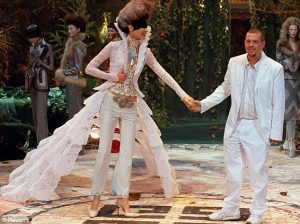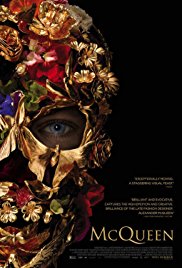Is there a type of person whose early departure from this mortal coil could have been predicted early on? The list of incandescent flames that burned out quickly is quite long—from Byron, Keats, and Shelley to Hendrix, Joplin, and Cobain—and Alexander McQueen clearly belongs to this roster. A suicide at age forty, he produced more work—more lines of dresses, more runway shows, more zany happenings that turned fashion into performance art—in twenty years than other designers produce in a long career, or never produce. As so often in these cases, the manic energy was fueled by chemicals, with cocaine being the drug of choice, though he was no stranger to alcohol.
The forward propulsion of this film nicely conveys the mad ambition that drew McQueen upwards, such that he was hired to be chief designer of Givenchy at the age of 27 (the year was 1996). The drawback of this approach is that we never pause for long to figure out what made him run. We see him scribbling, stitching, dressing models, taking bows, and occasionally talking to the camera, always in cryptic sound bites with nary a complete sentence to be heard. His childlike enthusiasm reminds one of Warhol, along with his general refusal to elaborate on his vision for a given show, or for fashion in general, beyond throwing out adjectives like new, fantastic, or mind-blowing. There’s some suggestion that his fascination with the grotesque went back to childhood abuse, but certainly McQueen himself is not forthcoming on this point. Like Warhol, he seems to have possessed a nonverbal imagination that enabled him to create amazing things without being able to explain what he was doing.
This documentary was shown at the Provincetown International Film Festival in June.





